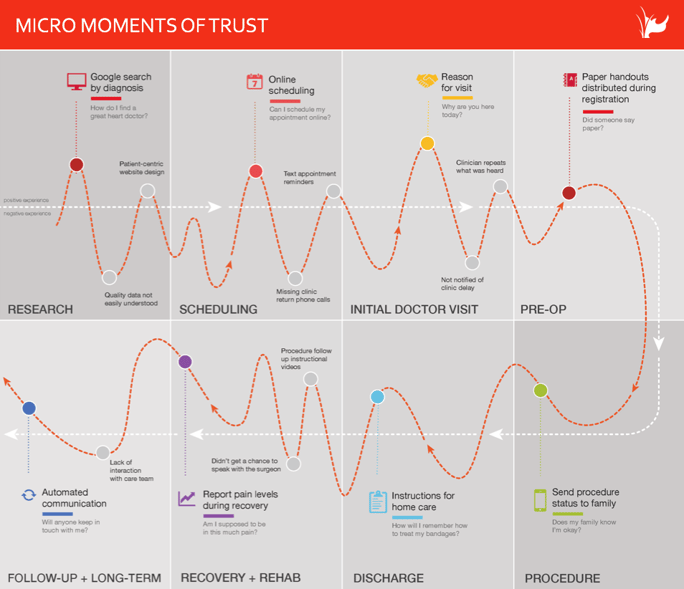It’s no secret that the days of “fee-for-service” are nearing an end. What might be less obvious is how this shift to value-based care should impact your healthcare marketing strategy. It’s time to get ready to figure out how your marketing can support more efficient and cost-effective patient acquisition and retention programs. Here are a few steps you can take to get started.
1. Advertising without the ads
Consumers — just like you and me — have been trained to ignore ads. We tune out tv and outdoor ads, ignore online display and search advertising, and even upgrade digital services like Pandora to be ad-free. So as healthcare marketers we have a choice: Create more noise or develop programs that build trust, loyalty and 1:1 personal relationships between our brands and customers.
How might we do this in healthcare? Instead of a traditional marketing campaign, take a value-based approach to your next healthcare marketing effort and focus on extending the relationship that patients form with their clinicians.
With today’s digital tools, there’s no better way to do this than by developing a clinical service line-specific “companion app” that patients can get real value from.
Take a look at this study: A mobile companion app was created for women who were planning to have a cesarean delivery. Thirty women were asked to download this app one month before their planned cesarean. The clinician-prescribed app was chock-full of pre- and post-surgery info along with appointment reminders.
The results? Hospital stays for these women decreased by one day. According to the study, “when factoring in the amount saved with the app, researchers found an average savings of 216 percent in the first year of implementation and an estimated 285 percent in the following years.”
Wow. Marketing that actually impacts health outcomes?
Clinical companion apps like this are an important marketing strategy for expanding the digital footprint of the care team, hospital and health system beyond the physical walls of the practice. It’s all about creating memorable experiences where patients are interacting with the hospital brand without the feeling that they’re being sold to.
The healthcare marketer of the future isn’t spending their budget and time on channels that interrupt customers from their daily routine — they’re creating digital health solutions that create new ones by engaging patients in more meaningful ways.
2. Consider the entire patient experience – beyond your website
By 2018, 25 percent of CMS reimbursement will come from patient satisfaction scores – making value-based marketing a priority in healthcare. We need to get better at interacting with patients and anticipating their needs – not just within the walls of the hospital but across their entire healthcare experience.
Journey mapping is a great tool for identifying the steps in a customer’s decision-making process – before, during and after they visit your organization.
You can begin by mapping out a patient’s journey — from research and scheduling to recovery and rehabilitation (and beyond) — to identify opportunities to build trust with your brand. Are patients greeted with a push notification when they park in your garage? Are families given helpful and easy to use directions when they walk through your entrance? What methods does the clinician use to get to know the patient? Does your hospital keep in touch with patients post-discharge ensuring recovery compliance to avoid readmission?

Sample healthcare journey map. Download the worksheet to start your own.
As part of your journey mapping, it’s important to identify the highs and lows of what a patient can experience. Next, consider ways to build new experiences into those lows to elevate what your patients are currently experiencing — this is where a digital health solution often comes into focus.
By identifying moments in your patient journeys that you can build a deeper relationship and trust with patients you’ll be well on your way to higher patient satisfaction scores. One strategy might even be in how those surveys get distributed (Hint: no more paper).
3. Show your C-suite what you’re made of
For value-based care to come to your hospital, you need smart marketers who know how to make it happen. (Check that box. You’re reading this article.) But you also need a CEO who makes it his or her mission to support you and make it happen.
I’ve had so many inspiring conversations at healthcare conferences this year talking about inbound marketing for healthcare, digital health companion apps and healthcare consumerism-inspired hospital website redesigns. But for every trailblazing healthcare marketer I meet, there are 10 who feel stagnant in their position — they share that they can’t get the organization to support online appointment scheduling, can’t get an email nurture program off the ground or help build a mobile in-building wayfinding experience (see Piedmont Now — it’s quite remarkable).
These new healthcare marketing strategies require that you have the support of your patient experience teams, IT, operations, quality teams, and even the nurses and doctors that will drive patient adoption of these digital health solutions.
Your ally in all of this is your CEO.
For example, let’s take a look at Ochsner Health System (also a White Rhino client). While the Louisiana-based system isn’t ranked as highly as Cleveland Clinic or Mayo Clinic, the hospital’s CEO Warner Thomas has instead developed the health brand in a different way: They aim to be the most tech-wired hospital in the country. Warner’s leadership has allowed all sorts of digital health solutions to come to life – from its well-known O-Bar stocked with curated mobile health apps to completely re-imagining the online quality and safety experience.
To launch the types of hospital-wide brand experiences I’ve discussed in this article, you’ll need the organization to support (among other things) a CRM strategy, expanding your patient portal beyond just a filing cabinet repository of health records, and a digital personalization approach that won’t violate HIPAA.
So how exactly do you get the CEO and the rest of the organization on your side? It starts with the same approach you would use to build trust with your patients: journey mapping.
On the journey to value-based care consider what’s important to the C-suite as they evaluate the marketing strategies you put in front of them. CIO’s spend entire careers seeing an EHR implemented – and actually adopted – so show that you’re considering how to make the best use of what’s already in place before suggesting an investment in another new technology.
Meanwhile, CFOs need to understand the return on the investments you're proposing. And a CEO may not find value in the number of impressions or clicks from online ads, but will pay attention when you show how you grew CRM activity by 400% or lowered readmissions.
By identifying what’s important to your stakeholders, you will build deeper relationships, trust and vision alignment to deliver better brand experiences for patients.
It's time to embrace value-based healthcare marketing strategies. They're critical for keeping your marketing relevant – both to patients and your organization.



